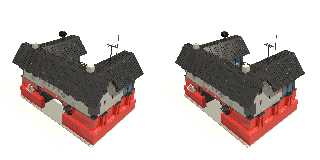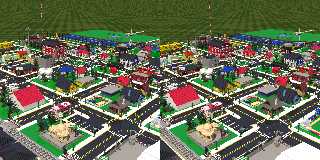 |
 |
|
 |
|
 |
|  |
|  |
|
 |
|
 |
|  |
|  |
|
 |
Le 16-01-18 23:49, Mike Horvath a écrit :
> Here's a stereoscopic version, since I got my stereoscope in the mail
> this week. I used StereoPhoto Maker to assemble the image.
>
> I am disappointed that:
>
> 1. The printed images are so small. If I print them larger, then they
> are out of focus due to the magnification of the lenses.
> 2. At small sizes, the printed images are not very crisp. Maybe taking
> the images to a photo lab will produce better results than my desktop
> printer.
> 3. The colors are much darker when printed than in the program preview.
> 4. I'm still not sure if I should make the cameras converge on a single
> point or not. I'm not sure which is better.
> 5. If I mess with the paper orientation in the printer dialog, then the
> images get cropped or misaligned in weird ways, wasting paper and ink.
> It's better to stick with the defaults I guess.
> 6. The program doesn't label the left and right source images, so I
> forget which is which. Because of this I don't know for sure whether the
> stereoscope uses the cross-eyed method or not.
> 7. I can't figure out how to resize the program window so that I can
> preview the images using the stereoscope before printing.
>
> Otherwise, the experience was okay, and did not require a lot of
> preparation or configuration to get good results.
>
>
> Mike
Parallel view. It print small so that it'spossible to view that way.
If you print larger, then, you'll need mirrors to compensate for the
larger size.
Print using the highest DPI setting available. Home printers should be
able to go up to 1400 DPI or more without problem.
Having convergence or not is dependent on the scale of the scene.
Converging for compact, close up images.
Non-converging for vast scenes like this one.
Flip the images and print at a larger size for cross-eyed view.
Alain
Alain
Post a reply to this message
|
 |
|  |
|  |
|
 |
|
 |
|  |
|  |
|
 |
On 1/19/2016 11:11 AM, clipka wrote:
> Am 19.01.2016 um 14:59 schrieb Cousin Ricky:
>> Mike Horvath <mik### [at] gmail com> wrote:
>>> 6. The program doesn't label the left and right source images, so I
>>> forget which is which. Because of this I don't know for sure whether the
>>> stereoscope uses the cross-eyed method or not.
>>
>> This image pair is definitely not cross-eyed.
>
> I think it definitely is.
>
Cousin Ricky is right. It is not.
Mike com> wrote:
>>> 6. The program doesn't label the left and right source images, so I
>>> forget which is which. Because of this I don't know for sure whether the
>>> stereoscope uses the cross-eyed method or not.
>>
>> This image pair is definitely not cross-eyed.
>
> I think it definitely is.
>
Cousin Ricky is right. It is not.
Mike
Post a reply to this message
|
 |
|  |
|  |
|
 |
|
 |
|  |
|  |
|
 |
Here's another image.
Post a reply to this message
Attachments:
Download 'l3p_building_031_carriagehouse_lgeo_stereoscopic_both.png' (808 KB)
Preview of image 'l3p_building_031_carriagehouse_lgeo_stereoscopic_both.png'

|
 |
|  |
|  |
|
 |
|
 |
|  |
|  |
|
 |
Am 19.01.2016 um 18:22 schrieb Mike Horvath:
> On 1/19/2016 11:11 AM, clipka wrote:
>> Am 19.01.2016 um 14:59 schrieb Cousin Ricky:
>>> Mike Horvath <mik### [at] gmail com> wrote:
>>>> 6. The program doesn't label the left and right source images, so I
>>>> forget which is which. Because of this I don't know for sure whether
>>>> the
>>>> stereoscope uses the cross-eyed method or not.
>>>
>>> This image pair is definitely not cross-eyed.
>>
>> I think it definitely is.
>
> Cousin Ricky is right. It is not.
Took me another while of staring at the image, but yes, you're right indeed. com> wrote:
>>>> 6. The program doesn't label the left and right source images, so I
>>>> forget which is which. Because of this I don't know for sure whether
>>>> the
>>>> stereoscope uses the cross-eyed method or not.
>>>
>>> This image pair is definitely not cross-eyed.
>>
>> I think it definitely is.
>
> Cousin Ricky is right. It is not.
Took me another while of staring at the image, but yes, you're right indeed.
Post a reply to this message
|
 |
|  |
|  |
|
 |
|
 |
|  |
|  |
|
 |
On 1/19/2016 12:21 PM, Alain wrote:
> Having convergence or not is dependent on the scale of the scene.
> Converging for compact, close up images.
> Non-converging for vast scenes like this one.
>
> Flip the images and print at a larger size for cross-eyed view.
I tested both methods, and convergence definitely looks better. Even on
my largish scene.
Mike
Post a reply to this message
|
 |
|  |
|  |
|
 |
|
 |
|  |
|  |
|
 |
Here is the same scene again, except the cameras converge.
Mike
Post a reply to this message
Attachments:
Download 'l3p_datsville_townview_boxed_stereoscopic_both.png' (2118 KB)
Preview of image 'l3p_datsville_townview_boxed_stereoscopic_both.png'

|
 |
|  |
|  |
|
 |
|
 |
|  |
|  |
|
 |
On 1/19/2016 12:21 PM, Alain wrote:
> Print using the highest DPI setting available. Home printers should be
> able to go up to 1400 DPI or more without problem.
Also, here are the specs for my printer.
http://support.brother.com/g/b/spec.aspx?c=us&lang=en&prod=mfcj825dw_all
The highest quality has a pretty good dpi, but to me the images still
look fuzzy. I wonder if big box stores like Staples can print at higher
resolution. Or maybe a regular photo lab.
Mike
Post a reply to this message
|
 |
|  |
|  |
|
 |
|
 |
|  |
|  |
|
 |
On 1/19/2016 1:38 PM, Mike Horvath wrote:
> On 1/19/2016 12:21 PM, Alain wrote:
>> Print using the highest DPI setting available. Home printers should be
>> able to go up to 1400 DPI or more without problem.
>
> Also, here are the specs for my printer.
>
> http://support.brother.com/g/b/spec.aspx?c=us&lang=en&prod=mfcj825dw_all
>
> The highest quality has a pretty good dpi, but to me the images still
> look fuzzy. I wonder if big box stores like Staples can print at higher
> resolution. Or maybe a regular photo lab.
Actually, those are nominally poor specs for graphics printing.
(203x196) Sure, print your iPhone photos, but for the density of your
pic, it's pretty weak. And they don't mention the size of the smallest
dot, usually on low end 300x300 printers it's 1/72 inch for black and
1/40 inch for color. I'll bet you get lots of bleed.
203x196 (not even 300x300!) means they used cheap servos that can't
accurately position the head and paper and were too cheap to even use a
reduction gear.
Definitely go check out the photo shop at walmart. You can run some
1200x1200 (or maybe 1440x1440) photo-chemistry test prints fairly cheap.
Alain, 1400 dpi on a home/inkjet printer is only a half truth. That
defines how accurately the paper and head can be positioned, but there
is no chance of spraying 3 colored dots of ink in a 0.0007 inch square.
It's not chemically possible. You need to know the size of the dot to
determine actual resolution.
(I'm not a printing expert, but I played one on TV
http://patft.uspto.gov/netacgi/nph-Parser?patentnumber=4728783 ;) )
Post a reply to this message
|
 |
|  |
|  |
|
 |
|
 |
|  |
|  |
|
 |
On 1/19/2016 3:19 PM, dick balaska wrote:
> Actually, those are nominally poor specs for graphics printing.
> (203x196) Sure, print your iPhone photos, but for the density of your
> pic, it's pretty weak. And they don't mention the size of the smallest
> dot, usually on low end 300x300 printers it's 1/72 inch for black and
> 1/40 inch for color. I'll bet you get lots of bleed.
>
> 203x196 (not even 300x300!) means they used cheap servos that can't
> accurately position the head and paper and were too cheap to even use a
> reduction gear.
>
> Definitely go check out the photo shop at walmart. You can run some
> 1200x1200 (or maybe 1440x1440) photo-chemistry test prints fairly cheap.
> Alain, 1400 dpi on a home/inkjet printer is only a half truth. That
> defines how accurately the paper and head can be positioned, but there
> is no chance of spraying 3 colored dots of ink in a 0.0007 inch square.
> It's not chemically possible. You need to know the size of the dot to
> determine actual resolution.
>
> (I'm not a printing expert, but I played one on TV
> http://patft.uspto.gov/netacgi/nph-Parser?patentnumber=4728783 ;) )
>
>
>
For regular printing, the spec sheet says "Resolution Up to 1200 × 6000
dpi", which works out to 1 dot in 0.01290994448735805628393088466594
inches. Maybe you were looking at the Fax section?
Mike
Post a reply to this message
|
 |
|  |
|  |
|
 |
|
 |
|  |
|  |
|
 |
On 1/19/2016 6:21 PM, Mike Horvath wrote:
> For regular printing, the spec sheet says "Resolution Up to 1200 × 6000
> dpi", which works out to 1 dot in 0.01290994448735805628393088466594
> inches. Maybe you were looking at the Fax section?
>
>
> Mike
Never mind. Dots per inch is measured in a straight line, not an area.
Mike
Post a reply to this message
|
 |
|  |
|  |
|
 |
|
 |
|  |




![]()